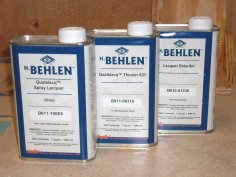 The
purposes of applying these shiny top coats are twofold. First, they
will protect the guitar from the day to day abuse you will unto it
render. Second, it will give you a thick, built-up surface which you
can rub out to that kick-ass glossy shine. The
purposes of applying these shiny top coats are twofold. First, they
will protect the guitar from the day to day abuse you will unto it
render. Second, it will give you a thick, built-up surface which you
can rub out to that kick-ass glossy shine.
Buy the high gloss “spray” lacquer, not the “brushing” lacquer as we
will obviously be spraying and not brushing. I mixed up small
batches as I needed them. You can always make more quickly since
there is no wait time to dissolve like there was with the shellac.
Following the directions on the can of spray lacquer, I mixed 200ml
of spray lacquer (about 7 ounces) with 200ml of the spray lacquer
thinner (about 7 ounces) with 5% lacquer retarder (10ml or about 3/8
of an ounce). This should make enough for about 6 coats on the
guitar. A quart each of lacquer and thinner should be enough to coat
the guitar with all the coats you’ll desire. Refer back to the
discussion on spraying techniques as they’re the same for lacquer as
it was for shellac.
Schedule for applying the lacquer coats:
● As mentioned earlier, lacquer thinner is toxic and explosive.
Please take the necessary precautions.
● Spray on one coat and let the guitar dry for at least one hour.
● Spray on a second coat and let it dry for at least one hour.
● Spray on a third coat and let it dry for two days.
● Very lightly sand with 400 grit, vacuum the surface, and wipe it
with a tack cloth.
● Repeat the process for a total of 10, 2-day processes (making a
total of 30 coats). You’ll start to see the build up and leveling of
the finish after about 9 coats. Any open grain in porous wood (like
mahogany) will start to plane out.
● After your last coat, let the lacquer cure for at least one week.
That’s right, one full week. The lacquer has to have time to fully
cure or you will not be able to rub it out to that glossy finish.
Depending on your personal schedule, you can always wait longer
between coats. Just don’t spray or sand any sooner or the previous
coat may not be fully dry. If your sanding does not produce dust,
stop immediately and let it sit another day. Lacquer is unique in
that it works by “melting” into or “reactivating” the previous coat.
If you become impatient on coat number 11 and you lay on one extra
thick coat, it will take considerably longer to dry. The longer it
stays wet, the longer it continues to reactivate the 10 previously
applied coats. If you’re not careful you’ll end up with one thick
coat of jelly drooping, sagging, and running off your guitar. Then
it’s back to stripping the whole thing and starting over again. The
risk is too great. Be patient! |